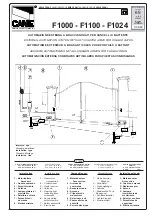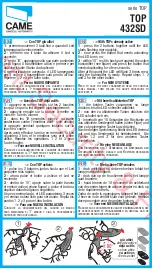
Notes to
Table 4
:
– The Table states the values available for each of the 4 special functions and
the corresponding key to be pressed on the transmitter for selection of the spe-
cific value.
– The factory settings are highlighted in grey.
11
– MEMORISING A NEW TRANSMITTER WITH PROCEDURE
IN THE VICINITY OF THE CONTROL UNIT
[with a transmitter already memorised]
A NEW transmitter can be memorised in the control unit memory without acting
directly on key
P1
of the control unit, but by simply working within its reception
range. To use this procedure, an OLD transmitter, previously memorised and
operative, is required. The procedure enables the NEW transmitter to receive
the settings of the OLD version.
Warning
–
The procedure must be performed within the reception range
of the receiver (maximum 10-20 m from receiver).
01.
On the NEW transmitter, press and hold the key to be memorised for at
least
5 seconds
and then release.
02.
On the OLD transmitter, slowly press the control key to be memorised on
the other transmitter
3 times
.
03.
On the NEW transmitter, press the same key pressed in point 01
once
.
Note
– Repeat the same procedure for each key to be memorised.
12
– DELETING DATA FROM THE CONTROL UNIT MEMORY
Data in the control unit memory can be deleted partially or totally as required. To
do this, the following procedures can be used, as required:
• Deletion of a command on a transmitter already memorised
• Deletion of other data memorised on the control unit
Deleting a command on a transmitter already memorised
The following procedure enables deletion of a single command assigned to a
transmitter key from the control unit
memory
.
Note
– During the procedure, the red and green leds remain permanently lit.
01.
Press and hold the key “
P1
” on the Control unit for at least
10 seconds
: the
green Led illuminates first, then the
red
led illuminates after 5 seconds and
then both, to indicate that the Control unit has entered memory deletion
mode (
WARNING
!
do not release the key P1!
).
02.
Without releasing key
P1
press the transmitter key to be deleted: if the
control unit recognises this operation, the
green
led emits a short flash,
after which the
P1
key and transmitter key can be released.
TABLE 4
AUTOMATIC CLOSURE
No closure —> (press key “
T1
”)
Closure after 15 seconds —> (press key “
T2
”)
Closure after 30 seconds —> (press key “
T3
”)
Closure after 60 seconds —> (press key “
T4
”)
MOVEMENT SPEED
Low
Opening /
Low
closing —> (press key “
T1
”)
Low
Opening /
Fast
closing —> (press key “
T2
”)
Fast
Opening /
Low
closing —> (press key “
T3
”)
Fast
Opening /
Fast
closing —> (press key “
T4
”)
SENSITIVITY TO OBSTACLES
High
—> (press key “
T1
”)
Medium high
—> (press key “
T2
”)
Medium low
—> (press key “
T3
”)
Low
—> (press key “
T4
”)
PRESSURE DISCHARGE
No discharge —> (press key “
T1
”)
Minimum
—> (press key “
T2
”)
Medium
—> (press key “
T3
”)
Maximum
—> (press key “
T4
”)
Deleting other data memorised on the control unit
The following procedure enables deletion of various types of memorised data
from the control unit
memory
, as specified in
Table 5.
Note
– During the procedure, the red and green leds remain permanently lit.
01.
Press and hold the key “
P1
” on the Control unit for at least
10 seconds
:
the
green
Led illuminates first, then the
red
led illuminates after 5 seconds
and then both, to indicate that the Control unit has entered memory dele-
tion mode. Then release the key.
02.
With reference to
Table 5
, select the data to be deleted and press
P1
the
same number of times as the number of presses specified in brackets
(the
green led emits one flash each time the P1 key is pressed).
03.
5 seconds after the key “
P1
” is pressed for the last time, if deletion is suc-
cessful, both leds (red and green) flash quickly
(= memory deleted!)
.
Note
– Before deletion, there is a margin time of 5 seconds, in which the
user has the option to change decision and exit the procedure without
deleting data by pressing key P1 five times.
IMPORTANT!
- After deletion of the “Memory of
Closing
and
Opening
limit
positions” and “TOTAL Memory”, the procedure 9.2 – “
Learning the
Closing
and
Opening
limit positions
” must be repeated.
TABLE 5
• Memory of Optional Function values (=
1 press
)
• Memory of “
Closing
” and “
Opening
” limit positions (=
2 presses
)
• Memory of Transmitters (=
3 presses
)
• TOTAL memory (=
4 presses
)
Note – deletes the first three memories in
one process
E
N






































